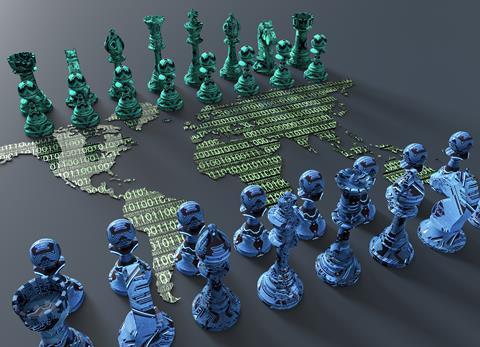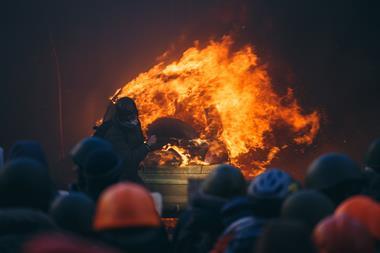Security intelligence must be integrated into Enterprise Risk Management, if businesses are to manage growing geopolitical threats, argues Matt Ince, associate director at Dragonfly
Multinationals’ ability to understand the nature of the threats they face around the world may fall short unless they recognise that tomorrow’s geopolitical crises are unlikely to mirror current ones.
The crises of the future will have multiple drivers. They will likely emerge from a confluence of political, security, economic, environmental, and technological factors shaping a new, more volatile, and complex risk landscape.

In order to better navigate this landscape, companies should widen their approach to geopolitical risk by thinking more geo-strategically, analysing how the confluence of these factors might impact their business, then ensuring the assessments feed into investment and strategic decision-making.
Thinking and acting more geo-strategically allows businesses to make timely decisions that enable them to maintain their position and advantage relative to competitors. Those who don’t operate in this way are more likely to be taken by surprise or even overwhelmed by unfolding global developments, leaving them unable to maintain their competitive edge.
“The sources of instability are now more diverse”
The case for adopting a more geo-strategic approach is strengthened as existing assumptions about geopolitics are becoming outdated.
The sources of instability are now more diverse. They range from growing autocratisation, the rebalancing of military power, AI-generated cyber risks, more frequent and severe environmental shocks, and competition over new geographic frontiers.
These have the potential to influence current geopolitical trends, disputes and crises as well as combine to create new points of tension. So, how will these emerging risks trigger instability?
Autocratisation on the rise
With autocratisation, we’re increasingly seeing nominally democratic states becoming authoritarian and states that are already authoritarian veering towards autocracy.
Autocratisation is ongoing in 42 countries, home to 2.8 billion people, or 35% of the world’s population. This is according to the Varieties of Democracy (V-Dem) Institute’s latest annual report which was published in March and considers the state of democracy worldwide.
In transitioning between governance systems, these countries are susceptible to regime and societal stability risks. With democratic erosion and autocratic consolidation, there are fewer safety valves for social grievances to be released, raising potential for coups and regime stability risks. This becomes more likely if economic policies lead to widespread hardship and/or social contracts are broken.
Multipolarity creates new nuclear rivalries
The rebalancing of military power (stemming from the emergence of a multipolar world) combined with the expansion of nuclear arsenals globally, are raising the potential for miscalculation in diplomatic disputes, dangerous standoffs, and unintended escalation in tensions between nations.
There are two reasons why such scenarios are more likely: the erosion of governance mechanisms to manage and provide safeguards for nuclear weapons; and the apparent willingness of some states to use these weapons.
AI multiplies cyber threats
Regarding the technology space, AI advances allow cyber threat actors to scale their activities. AI can essentially multiply the impact of cybercrime.
So, for instance, authoritarian states could use AI-enabled tools and applications to step up efforts in Western democracies to erode public trust in institutions through the proliferation of deep-fake information.
They might also exploit the new technology to be more repressive, for instance to increase their capacity to silence dissent at home and abroad, via disinformation and other means.
Global temperature rise exacerbates instability risks
Severe impacts of climate change are now occurring at lower temperatures than was previously expected by most experts. Accelerating global heating is contributing towards soaring economic losses, supply chain disruptions and is increasing the potential for violent conflict by adding to existing socio-economic pressures and grievances.
Challenges presented by such risks are likely to become compounded further still, as co-occurring extremes – where the adverse human, economic and environmental effects of extreme climate events take place concurrently – become the norm rather than the exception across several regions.
New geographies become potential flashpoints
Turning to the new frontiers of geopolitical tensions, we are already seeing strategic competition over polar regions, deep-sea and space – creating new flashpoints from which crises can unfold.
All three domains are increasingly recognised as sources of critical minerals necessary for digitalisation and the green energy transition. There are governance frameworks to manage disputes over these new frontiers, but they are often out-of-date and don’t have teeth – therefore vulnerable to circumvention.
At the same time, the reserves of critical minerals in the new frontiers are of growing interest because traditional sources are being squeezed, amid escalating competition to access, and monopolise, supply chains.
China, for instance, not only monopolises the extraction but also the processing of critical minerals, meaning it is potentially able to limit their supply through export bans, as a way of exerting pressure on the West.
Business response to changing threat landscape
The convergence of these trends is creating a more nuanced, unpredictable risk landscape. So, in addition to being across existing global threat trends and their most likely consequences, businesses must anticipate and understand how potential new sources of instability can unfold, if they are to build real resiliency into their operations.
Developing capacity to do so requires strategic foresight, whether that’s scenario-generation, war-gaming or other types of activities that enable companies to think through the most likely consequences of different future scenarios.
The outcome of these exercises must then feed directly into high-level strategic decision-making processes. This not only ensures companies remain on the front foot in the face of immediate and medium-term threats but can also proactively identify business opportunities in regions with lower-risk profiles.
“Businesses must anticipate and understand how potential new sources of instability can unfold, if they are to build real resiliency into their operations”
Essentially, what this means is the integration of security intelligence, long primarily concerned with tactical and operational considerations, into enterprise risk management.
So, for security intelligence teams within businesses, there is an opportunity to add enhanced business value by pushing their geostrategic assessments upwards to c-suite and business leaders, as these assessments will increasingly be critical to corporate planning.
Multinationals have long focused on geopolitical risk analysis to keep their staff and assets safe. This is no less important today, but the emergence of new sources of instability mean the threat landscape is more complex and volatile.
It should be viewed through a geostrategic lens to capture this complexity, make sense of it, and forewarn decision-makers of risks and opportunities. Such an approach will become ever more important, as multinationals continue to diversify their supply lines in the wake of Covid, increasing their operational exposure to the new points of tension.
Matt Ince is an associate director at Dragonfly, a geopolitical and security intelligence firm, where he leads on strategic intelligence.
Prior to joining Dragonfly in January 2023, Matt spent a decade working within the UK’s national security community, including leading analysis on emerging global risks and strategy development on the security implications of climate change.
He is an Associate Fellow at the Royal United Services Institute (RUSI), the UK’s leading, defence and security think tank, and a Research Associate at the University of Oxford’s Climate Change and (In)security Project.














No comments yet